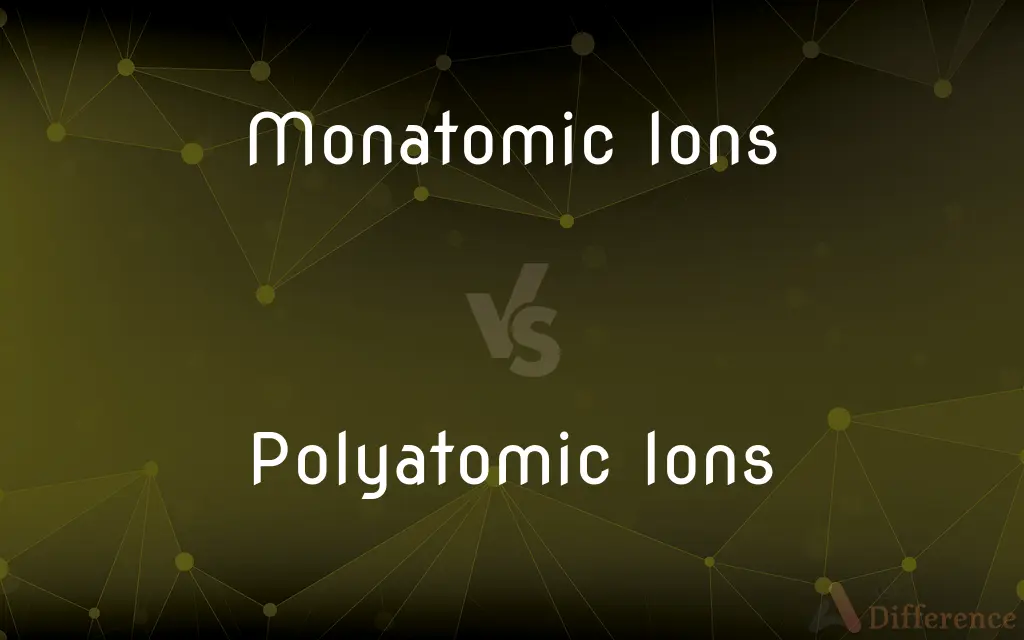Monatomic Ions vs. Polyatomic Ions — What's the Difference?
By Tayyaba Rehman — Published on November 17, 2023
Monatomic ions consist of a single atom with a charge, while polyatomic ions consist of two or more atoms with a net charge.

Difference Between Monatomic Ions and Polyatomic Ions
Table of Contents
ADVERTISEMENT
Key Differences
The compelling world of chemistry introduces entities known as monatomic ions and polyatomic ions, each distinctive in structure and properties. Monatomic ions take the stage as solitary actors, comprising a single atom that bears an electrical charge due to the loss or gain of electrons. On the other side, polyatomic ions paint a more complex picture, featuring a group of atoms bonded together, collectively holding a net charge, showcasing the conglomeration of atoms behaving as a singular charged entity.
Diving deeper, monatomic ions embrace simplicity, formed when an atom gains or loses electrons, adjusting its electrical balance and consequently, manifesting a charge. Such simplicity, however, is contrasted by polyatomic ions which harbor a more complex nature, weaving a tapestry of interconnected atoms that jointly bear a charge, presenting a diverse array of atoms tightly knit into a single, charged entity.
In chemical formulas and equations, monatomic ions stand alone, represented by a single elemental symbol accompanied by a superscript indicating the charge. Conversely, polyatomic ions, while also brandishing a charge, reveal a more intricate portrait in chemical representations, with several atomic symbols bound together, indicative of the molecular architecture encompassed within the charged ensemble.
Monatomic ions offer a range of applications, particularly in electrolytic solutions, where their individual ionic nature plays a pivotal role in conducting electricity. Polyatomic ions, while also influential in electrochemical phenomena, provide a wider spectrum of application, participating in acid-base reactions, salt formations, and more, underlining the juxtaposition between the solitary character of monatomic ions and the complex utility of polyatomic ions.
In the realms of nomenclature, monatomic ions, with their singular atomic constitution, often derive their names straightforwardly from the element, albeit with an “-ion” suffix or a distinctive term in some cases (e.g., oxide for O²⁻). Polyatomic ions, enveloping multiple atoms, often adopt unique names, such as sulfate or nitrate, which might not directly reflect the atoms within, showcasing a linguistic divergence born from the structural disparity between monatomic ions and polyatomic ions.
ADVERTISEMENT
Comparison Chart
Atomic Constituents
Single Atom
Two or more atoms
Structural Complexity
Simple
Complex
Example
Na⁺, Cl⁻
SO₄²⁻, NH₄⁺
Nomenclature
Often derived from element name
Often adopt unique or common names
Electrical Conduction
In solutions, conduct electricity
In solutions, conduct and participate in reactions
Compare with Definitions
Monatomic Ions
Ionic Solitary Entities
In electrolyte solutions, monatomic ions like Cl⁻ facilitate electrical conductivity.
Polyatomic Ions
Covalently Bonded Ionic Groups
In acids, polyatomic ions like nitrate, NO₃⁻, often contribute to reactivity.
Monatomic Ions
Single Atom Bearers of Charge
Monatomic ions like Ca²⁺ play a vital role in bone health.
Polyatomic Ions
Bonded Atomic Aggregates with Charge
Biologically relevant polyatomic ions include phosphate, PO₄³⁻.
Monatomic Ions
Single Charged Atoms
Na⁺ and K⁺ are common monatomic ions in biological systems.
Polyatomic Ions
Complex Ionic Entities
NH₄⁺, a polyatomic ion, behaves as a base in aqueous solutions.
Monatomic Ions
Electron Losers or Gainers
When sodium loses an electron, it forms a monatomic ion, Na⁺.
Polyatomic Ions
Multifaceted Charged Molecules
Polyatomic ions like carbonate, CO₃²⁻, are central to geological formations.
Monatomic Ions
Isolated Ionic Participants
H⁺, a monatomic ion, is crucial in acid-base chemistry.
Polyatomic Ions
Charged Atom Clusters
The polyatomic ion sulfate, SO₄²⁻, is prevalent in various chemical reactions.
Common Curiosities
How are polyatomic ions structured?
Polyatomic ions comprise two or more atoms bonded together, possessing a collective net charge.
What role do monatomic ions play in electricity conduction?
Monatomic ions, when in a solution, can conduct electricity by moving towards electrodes.
What defines monatomic ions?
Monatomic ions are ions consisting of a single atom with a positive or negative charge.
How is the charge of monatomic ions determined?
The charge of monatomic ions is determined by the loss or gain of electrons.
How does the naming of monatomic ions differ from polyatomic ions?
Monatomic ions are often named based on the element, while polyatomic ions might have unique names like sulfate.
Are polyatomic ions always anions?
No, polyatomic ions can be either anions (negative) or cations (positive), like NH₄⁺.
What is an example of a monatomic cation?
A common example of a monatomic cation is sodium ion (Na⁺).
Can monatomic ions form salts?
Yes, monatomic ions like Na⁺ and Cl⁻ combine to form salts such as sodium chloride.
Can the charge on monatomic ions vary?
Yes, elements like iron can form monatomic ions with different charges: Fe²⁺ and Fe³⁺.
Can both monatomic ions and polyatomic ions be cations?
Yes, both can be cations (positive) or anions (negative), depending on electron loss or gain.
Are polyatomic ions always comprised of different elements?
No, polyatomic ions like O₂²⁻ consist of atoms of the same element.
Can polyatomic ions participate in acid-base reactions?
Yes, polyatomic ions like bicarbonate (HCO₃⁻) actively participate in acid-base reactions.
How are polyatomic ions utilized in agriculture?
Polyatomic ions like nitrate (NO₃⁻) are key components of fertilizers.
Can polyatomic ions exist in solid forms?
Yes, polyatomic ions can exist in solid salts, like ammonium chloride (NH₄Cl).
Are polyatomic ions involved in buffer systems?
Yes, polyatomic ions like bicarbonate are integral to biological buffer systems.
Share Your Discovery

Previous Comparison
Charismatic Leadership vs. Transformational Leadership
Next Comparison
Mammals vs. AmphibiansAuthor Spotlight
Written by
Tayyaba RehmanTayyaba Rehman is a distinguished writer, currently serving as a primary contributor to askdifference.com. As a researcher in semantics and etymology, Tayyaba's passion for the complexity of languages and their distinctions has found a perfect home on the platform. Tayyaba delves into the intricacies of language, distinguishing between commonly confused words and phrases, thereby providing clarity for readers worldwide.
















































